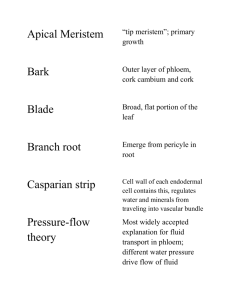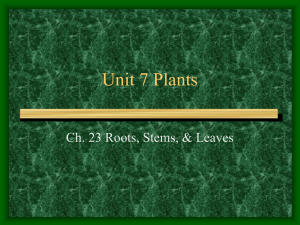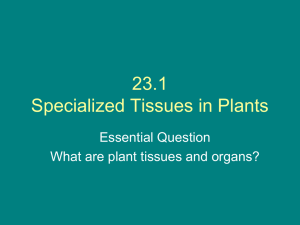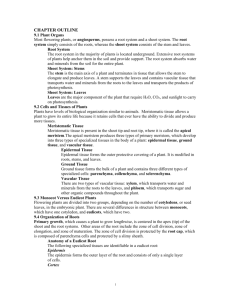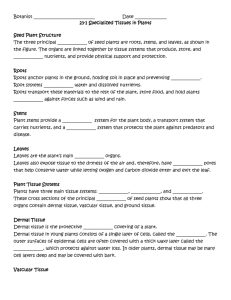File
advertisement
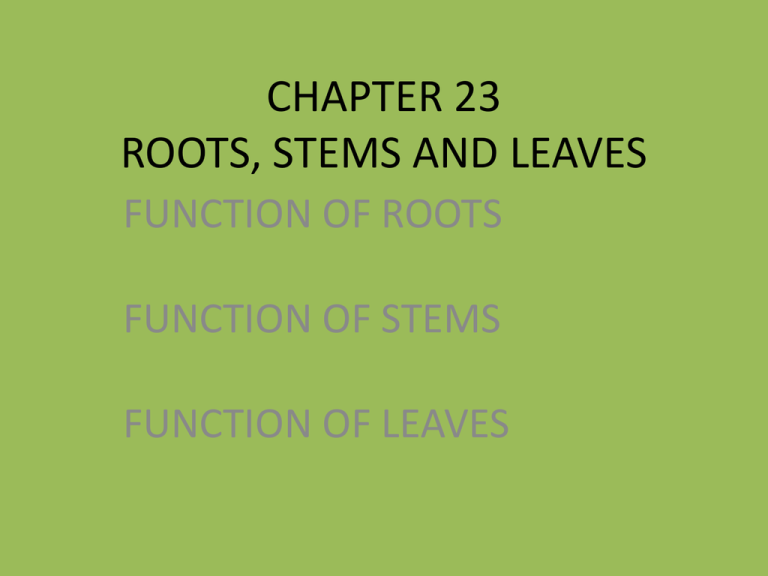
CHAPTER 23 ROOTS, STEMS AND LEAVES FUNCTION OF ROOTS FUNCTION OF STEMS FUNCTION OF LEAVES PLANT TISSUE SYSTEMS • DERMAL TISSUE • VASCULAR TISSUE • GROWTH TISSUE DERMAL TISSUE -outer covering of a plant consists of dermal tissue which consists of layers of epidermal cells. -dermal tissue is often covered a thick waxy layer that protects against water loss and injury - this waxy covering is called the cuticle. -some epidermal cells have tiny projections called trichomes which help protect the leaf and also give it a fuzzy appearance. Dermal Tissue continued • In roots dermal tissue includes root hair cells that provide a large amount of surface area and aid in water absorption. • On the underside of leaves, dermal tissue, contains guard cells, which regulate water loss and gas exchange. VASCULAR TISSUE • Forms a transport system that moves water and nutrients throughout the plant. • Main subsystems – xylem and phloem. • Contains specialized cells called tracheids and vessel elements (xylem); sieve tube elements and companion cells (phloem). • Both xylem and phloem are made up of networks of hollow connected cells that carry fluids throughout the plant • i. Xylem –Seed plants – xylem – tracheid cell –Tracheid cell: long, narrow cells with walls that are impermeable to water. –Openings in the cell wall connect neighboring cells. –When tracheids mature, they die, and their cytoplasm disintegrates. Seed plants – xylem – tracheid cell • Angiosperm xylem contains tracheid cells AND vessel elements. -vessel elements are wider than tracheid cells,like tracheid cells they mature and die before they conduct water. -arranged end to end on top of one another like a stack of tin cans. The cell walls are lost at both ends when the cells die, transforming the stack of vessel elements into a continuous tube tube through which water can move freely. ii. Phloem • Seed plants – phloem – sieve tube elements -Sieve tube elements – arranged end to end - like vessel elements, have many small holes in them – materials can move through these holes from cell to cell – as the cells mature they lose their nuclei and most other organelles – the remaining organelles hug the inside of the cell wall – the rest of the space is a conduit thru which sugars and other foods are carried in water. ii. Phloem • Companion cells are phloem cells that surround sieve tube elements. -keep their nuclie and other organelles -support the phloem cellls and aid in mov’t of substances in and out of the phloem. GROUND TISSUE • Cells that lie btw dermal tissue and vascular tissue make up the ground tissue – parenchyma cells -have thin cell walls and large central vacuoles surr by a thin layer of cytoplasm. • In leaves parenchyma cells are stacked with chloroplasts – site of photosynthesis. • Ground tissue may also contain two other types of cells which have a thicker cell wall: -collenchyma cells -sclerenchyma cells • -collenchyma cells -support cells – make up the strings of a stalk of celery. • -sclerenchyma cells – make ground tissue tough and strong. Plant Growth and Meristematic Tissue pp582 - 583 • Will do later. 23-2 ROOOTS • two main types of roots – taproots – found mainly in dicots and fibrous roots which are found in monocots. • 1. Taproot – the primary root grows long and thick while the secondary roots remain small. Ex. Carrots, dandelions, beets and radishes have thick taproots that store sugars and starches. • Fibrous roots – branch to such an extent that no single root grows larger than the rest – helps prevent topsoil from being washed away by heavy rain. • Ex. grasses Root Structure and Growth Root tissues Root hairs Cortex Endodermis Vascular cylinder Root cap ROOT FUNCTIONS pp586-588 • Anchors a plant in the ground and absorb water and dissolved nutrients from the soil. Essential Plant Nutrients – Nitrogen, Phosphorus, Potassium, Magnessium, Calcium Refer to chart on page 586 Root Function continued Important concepts: • • • • • i. Uptake of Plant Nutrients Ii. Active transport of Minerals Iii. Movement into the vascular cylinder Iv. Osmosis V. Root pressure 23-3 STEMS pp589-594 • Stem Structure and Function: -contains 3 tissues – g.t., v.t., d.t. 3 Important functions i. Produce leaves, branches and flowers ii. Hold leaves up to the sunlight. iii. Transport substances btw roots and leaves. STEMS continued Nodes are where leaves are attached. Internodes are regions btw the nodes Buds develop where leaves attach to the stem and contain underdeveloped tissue that can produce new stems and leaves. Woody tissue is developed by stems. Stems continued • Monocot stems – vascular bundles are scattered thruout the stem • Dicot stems and most gymnosperms vascular bundles are arranged in a cylinder. GROWTH OF STEMS pp590-591 • Primary growth – apical meristem – increases length of plant • Secondary growth – lateral meristematic tissue – increases thickness of plant -vascular cambium -cork cambium FORMATION OF WOOD, FORMATION OF BARK pp592-593 Assignment for next class determine how wood and bark are formed – from which tissues – is there a meristem involved? STEMS ADAPTED FOR STORAGE AND DORMANCY p594 • Tubers, rhizomes, bulbs, corms can remain dormant during cold or dry periods until favorable conditions for growth return. • Potato – tuber , ginger – rhizome, crocus bulb – corm, tulip bulb – bulb. 23-4 LEAVES pp595-598 • Leaf structure: -blades -petiole -mesophyll - palisade mesophyll - spongy mesophyll -stomata -guard cells. Transpiration and Gas Exchange pp596-597 • What is transpiration? • Where and how does gas exchange occur? • What factors regulate the opening and closing of stomata? • What is the function of guard cells? 23-5 TRANSPORT IN PLANTS pp599-602 • How is water transported through a plant? –Adhesion –Capillary action –Root pull –Transpiration What causes wilting? What is the pressure flow hypothesis? PLANT GROWTH AND MERISTEMATIC TISSUE pp582-583 • VOCABULARY: • meristems, meristematic tissue, apical meristem and • differentiation, root apical meristem, Root cap and • Zone of cell division, Z of elongation , Z of maturation







